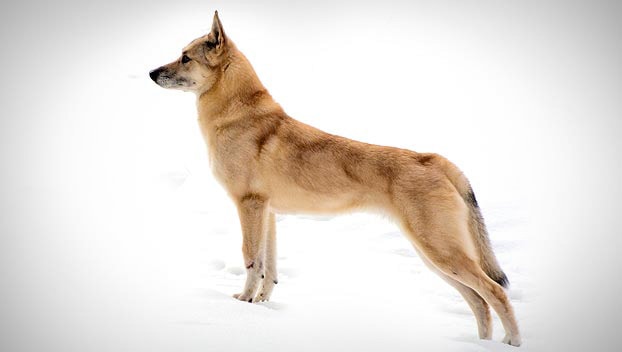Type the name of the breed you're looking for below
[wpdreams_ajaxsearchlite] Don't see the breed your're looking for? Click here and let us know!
Breed Characteristics
1 paw - breed exhibits the least amount of this characteristic
5 paws - breed exhibits most amount of this characteristic
Finnish Spitz
| Other Names | Finnish Hunting Dog, Finnish Spets, Finsk Spets, Loulou Finois, Suomalainen pystykorva, Suomenpystykorva |
| Country of Origin | Finland |
| Weight | 31 - 35 lbs. (14 - 16 kg) |
| Height (at withers) | 15 - 20 in. (38 - 51 cm) |
| Coat | The double coat has a short, soft, dense undercoat with a long, straight, harsh outer coat. |
| Colour | Coat colours include various shades of golden-red, red-brown and yellowish-red to honey-coloured, with or without small white markings. Puppies are born dark and lighten to a reddish colour as they get older. |
| Litter Size | 5 - 8 puppies, average 6 |
| Life Span | 12 - 15 years |
| Origin & History | The Finnish Spitz developed from selectively bred Spitz-type dogs that inhabited central Russia several thousand years ago. Isolated Finno-Ugrian tribes in the far northern regions bred dogs according to their specific needs. These small clans of woodsmen relied on their dogs to help them obtain food, and the excellent hunting ability of the Finnish Spitz made it a favorite choice. By 1880, as advanced means of transportation brought diverse peoples and their dogs together, Finnish Spitzes mated with other breeds of dogs, and were becoming extinct as a distinct breed. At about that time, a Finnish sportsman from Helsinki named Hugo Roos observed the pure native Finnish Spitz while hunting in the northern forests. He realized the many virtues of the pure Finnish Spitz breed and decided to select dogs that were untainted examples of the genuine Finnish Spitz in order to try to revive the breed. Thirty years of careful breeding resulted in the modern Finnish Spitz; the dogs are descendants of his original foundation stock. |
| Personality | The Finnish Spitz is friendly, active, playful, keen and courageous. It can be obedience trained, if the owner has an air of natural, gentle, calm, authority to them. The Finnish Spitz is renowned as a hunting dog, and also makes a great companion for family members of all ages, especially children and older adults. This breed does not fully mature until it is about 3 to 4 years old. The Finnish Spitz is aware of its place in the dominance hierarchy, and owners need to clearly communicate to the dog that its place is below all humans. Finnish Spitzes that believe they are higher in the order can become protective, demanding affection and attention, become domineering and can be fairly dog aggressive. Meek or passive owners will find them hard to manage. Socialize them well or they can be reserved and sometimes aloof with strangers. They are generally good with other pets. This breed is lively and curious, though not overwhelmingly so. They are loyal to their own families, but require much consistent patience and understanding. They are good watchdogs, but are not guard dogs. In Finland the Finnish Spitz is nicknamed the "barking bird dog." They were bred to bark a lot and even participate in barking contests, where it is not uncommon for a dog to bark over 150 times in one minute. They were bred to bark (which can sound like a yodel) continuously to point the hunter in the direction of the game bird, therefore you will never get this dog to be totally silent. If you leave the dog outside for long periods of time without the proper exercise or human leadership it can become a nuisance. Teach this dog enough is enough and to limit its barking. Do not allow it to bark at you, as a dog that barks at its owner is displaying dominance behaviors. With the right owner they can make wonderful pets. |
Care Requirements
| Health | The Finnish Spitz is typically a very healthy breed, with few general health concerns. However, breeders should be consulted to understand the prevalence of a specific disorder in this breed. Below is a short list of what is known to occur: Hip dysplasia Patellar luxation Elbow dysplasia Epilepsy |
| Grooming | The Finnish Spitz has a self-cleaning coat, as do most other Arctic dogs. Regular grooming with brush and comb is still necessary to remove dead hair. The coat does not have a doggie odor. This breed is a seasonally heavy shedder. |
| Exercise | The Finnish Spitz needs plenty of exercise, including daily, long walks or a jog, where the dog is made to heel beside or behind the human holding the lead, never in front, as instinct tells a dog the leader leads the way, and that leader needs to be the human. Simply running around a large backyard will not satisfy the canine's instinct to migrate. With enough proper exercise, it will be content to lie at your feet at night. This breed makes an excellent jogging companion. |
| Other Considerations | The Finnish Spitz will do okay in an apartment and without a yard provided it gets enough exercise. It is relatively inactive indoors and prefers cool climates. National dog of Finland |



